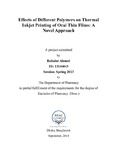Effects of different polymers on thermal inkjet printing of oral thin films: a novel approach
Abstract
The aim of this research was to use inkjet printing technology in formulation of personalized medicine. Thus in this research, an attempt was made to print OTF by TIJ printing. A placebo solution comprising of different polymers and polymer concentrations was used for TIJ printing on A4 paper. The formulations F1, F2, F3, F4, F5, F6, F7, F8, F9, F10, F11, F12 and F13 were prepared with the following compositions: (20% Glycerin+0.5% CMC+H₂O), (30% Glycerin+4% CMC+H₂O), (20% Glycerin+ 2% CMC+H₂O), (20% Glycerin+2%Gelatin+H₂O), (18% Glycerin+4% Gelatin+H₂O), (21% Glycerin+3.5% Gelatin+H₂O), (20% Glycerin+2% HPMC K4 MCR +H₂O), (12.5% Glycerin+1.25% HPMC K4 MCR +H₂O), (9.5% Glycerin+0.5% HPMC K4 MCR +H₂O), (20% Glycerin+1% HPMC K4 MCR +H₂O), (0.05% HPMC K4 MCR +49.98% H₂O+ 49.98% Ethanol) and (1% HPMC K4 MCR +H₂O) respectively. The placebo formulations were prepared by using glycerin as plasticizer and three different polymers; Carboxymethyl Cellulose (CMC), Gelatin and Hydroxypropyl Methyl Cellulose K4MCR (HPMC K4MCR) in different concentrations as film forming agents. The plasticizer and polymers were dissolved in aqueous solvent to prepare each placebo formulation with which the printer cartridge was refilled. Printing was done with the formulations using Canon PIXMA ip2772 thermal inkjet printer. F1 and F4 formulations, prepared with CMC and gelatin provided better imprint on paper at concentrations 0.5% and 2%, respectively. However, formulations prepared with HPMC K4MCR at a concentration as low as 0.05%, could not be jetted through the nozzle of the cartridge and no imprint could be obtained. Thus, from the study it was found that viscosity of the ink solutions affected the imprint quality.

